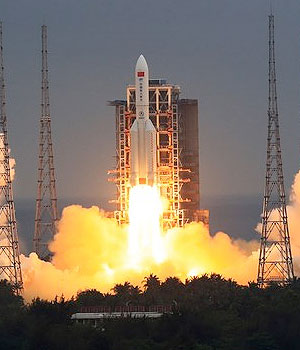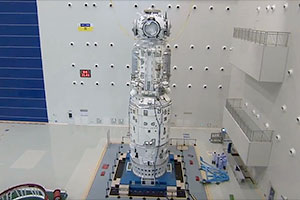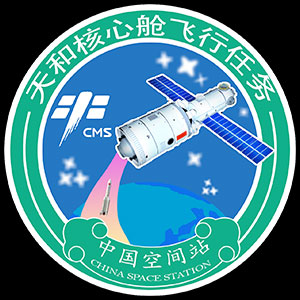April 28, 2021 — China has launched the core component of its first multi-module space station, reaching a milestone almost 30 years in the making.
The "Tianhe" module lifted off atop a Chinese Long March 5B Y2 rocket from the Wenchang Satellite Launch Center on Hainan Island, located in the South China Sea, on Wednesday (April 28). The 11:23 p.m. EDT (0323 GMT; 11:23 a.m. local April 29) launch marked the first of at least ten missions planned through the end of 2022 to support the assembly of the Tiangong (or "Heavenly Palace") station.
The 54-foot-long (16.6-m) Tianhe, or "Harmony of the Heavens" will serve as the space station's control hub. When complete, the T-shaped complex will also have two 47-foot (14.4-meter) laboratory modules, Wentian ("Quest for the Heavens") and Mengtian ("Dreaming of the Heavens"), extending from either side of Tianhe.
"We will learn how to assemble, operate and maintain large spacecraft in orbit," Bai Linhou, deputy chief designer of the space station at the China Academy of Space Technology. "We aim to build Tiangong into a state-level space lab supporting the long stay of astronauts and large-scale scientific, technological and application experiments,"
Before the two labs are launched, China plans to send a supply ship and a crew to begin testing the core module. Tianzhou-2, an uncrewed cargo vehicle, will deliver propellant to Tianhe before the Shenzhou 12 spacecraft lifts off with three Chinese astronauts to be the module's first residents for three months.
The Tiangong space station is designed to host three-person crews for up to six months at a time. The station is the next step in a three-part plan for the China Manned Space Agency, which began with a single astronaut launch in 2003. Since then, six more missions have launched 13 men and women, including three flights that docked to and ran operations aboard two Tiangong prototype spacelabs.
Imagery of Tianhe being prepared for launch showed the module has at least an exterior resemblance to the core module of Russia's former Mir space station. China has worked with Roscosmos, Russia's federal space corporation, on the development of its space program.
"The space station is also expected to contribute to the peaceful development and utilization of space resources through international cooperation, as well as to enrich technologies and experience for China's future explorations into deeper space," Bai said.
The Tiangong will be the world's third multi-module orbital complex, after Mir and the International Space Station (ISS), the latter supported by 15 nations including the U.S., Russia, Canada, Japan and the member states of the European Space Agency (ESA). Earlier stations, such as Russia's Salyut and the U.S. Skylab, were single module structures.
Tianhe and Wentian will be outfitted with exterior robotic arms. Mengtian will be equipped with an airlock. Visiting Tianzhou and Shenzhou spacecraft will dock with open ports on the core module, which in addition to the two laboratories, has a fifth port for a possible expansion.
"We did not intend to compete with the ISS in terms of scale," said Gu Yidong, chief scientist for the China Manned Space program. The Chinese Space Station's layout is "based on China's needs for scientific experiments" and "what we consider a reasonable size for the sake of cost-effectiveness." The CSS is less than one fourth the mass of the International Space Station.
Like the ISS, the interior walls of the Tiangong space station will be lined with refrigerator-size racks supporting experiments and crew life support systems. The science conducted on board will include research studies in life and material sciences, fluid physics, Earth observation and human physiology selected from domestic institutions and international partners.
The launch of the Tianhe core module was delayed after a 2017 Long March 5 launch failure. Instead of extending the timeline for the station's completion, China held by its 2022 target date and compressed the launch schedule.
China is also planning to launch into orbit its own Hubble-class space telescope, the Xuntian optical module, which will be able to dock with the CSS to be serviced and upgraded. |
|

A Chinese Long March 5B YE rocket lifts off from the Wenchang Satellite Launch Center with the Tianhe core module for the Tiangong space station on Wednesday, April 28, 2021. (Xinhua)

The Tianhe core module for China's Tiangong space station is seen being prepared for its launch. (CMSA)

Mission patch for the launch of Tianhe, the core module for China's Tiangong space station. (CMSA) |
